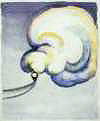|
DISCUSSION:
View and discuss
O'Keeffe's work. Ask the students the following questions:
- What type of
subject matter do you see in O'Keeffe's work?
- How would you
describe the colors that she used?
- Are the paintings
symmetrical or asymmetrical?
- Does the subject
look detailed or simplified?
- Does the artist
zoom in or pull back on the subject?
- What type of
paint does it look like O'Keeffe used?
Discuss Georgia
O'Keeffe the artist. (See links below for information)
Tell the students
they will be creating an O'Keeffe like painting, using her idea of subject
matter simplified into "interesting shapes that feel the space
in a beautiful way."(Quote of O'Keeffe's when describing an artist's
work that influenced her). Tell them they will also be using one of
O'Keeffe's favorite media, watercolor paint.
ASSIGNMENT:
Collect photographs
(or preferably real examples) of old bones, animal sculls, flowers,
seashells, and landscapes. Ask the students to look at them and think
about their shapes. In a class discussion have the students describe
the shapes in a single word, ex. curved, smooth, round, jagged, broken,
etc.
Tell the students
this quote of O'Keeffe's: "I see shapes in my head, sometimes I
know what they are and other times I don't."
Study and practice
the techniques used in watercolor painting and create a final painting
using O'Keeffe's abstract style of large, simple shapes.
PROCEDURE:
- Teach the students
how to do watercolor washes, including wet-in-wet, flat, and graded
washes.
- Allow the students
to practice these techniques.
- Teach the students
how to do a resist by trailing rubber cement with the pointed end
of a pencil onto paper. After the cement has dried, paint the areas
around the cement (the rubber cement will hold the paint in the shapes
and prevent the paint from mixing in different areas). After the paint
is dry, remove the cement by gently rubbing it off with your finger
or the eraser end of a pencil (be careful not to smear the paint).
The areas can then be outlined with a flair marker.
- Allow the students
to practice this.
- Demonstrate how
textures can be created in watercolor paint. Demonstrate using plastic,
a napkin, salt, and sponge. (See handout below for more explanation)
- Allow the students
to practice these techniques.
- Have the students
create several contour drawings of subjects. Use the subjects studied
at the set of this lesson. Stress using O'Keeffe like subjects and
simplified abstractions. Review the O'Keeffe examples again if needed.
- Let the students
choose their best drawing and crop areas away if it will improve their
composition.
- Have the students
redraw the contour drawing on watercolor paper. Draw lightly, so the
lines can later be erased. You may elect to use large sheets, similar
to O'Keeffe's large flower paintings. (O'Keeffe's idea was to force
the viewer to look at the flower and see it the way she saw it by
painting it very large.)
- Have the students
trail rubber cement on the pencil lines being careful to keep the
rubber cement on the lines. Students can hold a small piece of scrape
matte or poster board in their free hand to catch the cement trail
when they are finished with a line. Allow the rubber cement to dry.
- Paint in the
areas of shape with watercolor washes. Graded washed that create a
modeled look in the shapes will create a more O'Keeffe like appearance.
Review the paintings again if needed.
- Textures may
be added to areas of the painting as the students work. Even small
areas of texture, such as in the center of a flower, can add interest.
Tell the students this is not something that O'Keeffe used but it
is something that can add an interesting element to their painting.
- After the paint
is dry, remove the rubber cement. Erase the pencil lines that still
show. The white lines can be left as they are or can be outlined with
a flair. (Other edges in the painting can also be outlined with the
flair.)
SUGGESTIONS:
- Rubber cement
makes it easier for students to control the spread of the paint and
the textures are an easy way for students to experience success in
a difficult medium, but one or both can be left out of the lesson.
- Hair dries can
be used to speed up the drying process of the cement and paint.
- An O'Keeffe style
painting can also be done in pastels or acrylic paint.
CLOSURE:
Display the student
work and ask the students to discuss the successes and difficulties
they experienced in their paintings. Ask them what they would do differently
if they were to repeat the project.
RESOURCES:
Printable Handout
on Watercolor Paint
Publications:
Ragans, Rosalind. Art Talk. Columbus, Ohio: Glencoe,1995., pp.
266, 353.
Katz, Elizabeth L., Lankford, E. Louis, Plank, Jan D. Themes and
Foundations of Art. St. Paul: West, 1995., pp. 166, 230-231, 276.
Internet Links:
http://www.okeeffemuseum.org/indexflash.html
(Bibliography and some art work)
http://www.ellensplace.net/okeeffe1.html
(another bibliography)
http:/www.michelangelo.com/okeeffe/
(nice collection of art work)
|


